Chromite
Chromite is a mineral that is an iron chromium oxide. It has a chemical formula of FeCr2O4. It is an oxide mineral belonging to the spinel group. The element magnesium can substitute for iron in variable amounts as it forms a solid solution with magnesiochromite (MgCr2O4).[5] A substitution of the element aluminium can also occur, leading to hercynite (FeAl2O4).[6] Chromite today is mined particularly to make stainless steel through the production of ferrochrome (FeCr), which is an iron-chromium alloy.[7]
| Chromite | |
|---|---|
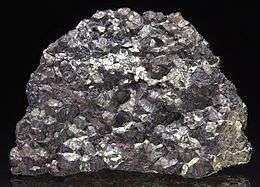 Chromite from Zimbabwe | |
| General | |
| Category | Oxide minerals Spinel group Spinel structural group |
| Formula (repeating unit) | (Fe, Mg)Cr2O4 |
| Strunz classification | 4.BB.05 |
| Crystal system | Isometric |
| Crystal class | Hexoctahedral (m3m) H-M symbol: (4/m 3 2/m) |
| Space group | Fd3m |
| Unit cell | a = 8.344 Å; Z = 8 |
| Identification | |
| Color | Black to brownish black; brown to brownish black on thin edges in transmitted light |
| Crystal habit | Octahedral rare; massive to granular |
| Twinning | Spinel law on {Ill} |
| Cleavage | None, parting may develop along {III} |
| Fracture | Uneven |
| Tenacity | Brittle |
| Mohs scale hardness | 5.5 |
| Luster | Resinous, Greasy, Metallic, Sub-Metallic, Dull |
| Streak | Brown |
| Diaphaneity | Translucent to opaque |
| Specific gravity | 4.5–4.8 |
| Optical properties | Isotropic |
| Refractive index | n = 2.08–2.16 |
| Other characteristics | Weakly magnetic |
| References | [1][2][3][4] |
Chromite grains are commonly found in large mafic igneous intrusions such as the Bushveld in South Africa and India. Chromite is iron-black in color with a metallic luster, a dark brown streak and a hardness on the Mohs scale of 5.5.[8]
Properties
Chromite minerals are mainly found in mafic-ultramafic igneous intrusions and are also sometimes found in metamorphic rocks. The chromite minerals occur in layered formations that can be hundreds of kilometres long and a few meters thick.[9] Chromite is also common in iron meteorites and form in association with silicates and troilite minerals.[10]
Crystal structure
The chemical composition of chromite is Fe2+Cr3+2O4.[4] Chromite, when presented as an ore, or in massive form, forms as fine granular aggregates. The structure of the ore can be seen as platy, with breakages along planes of weakness. Chromite can also be presented in a thin section. The grains seen in thin sections are disseminated with crystals that are euhedral to subhedral.[11]
Chromite contains Mg, ferric iron [Fe(III)], Al and trace amounts of Ti.[4] Chromite can change into different minerals based on the amounts of each element in the mineral.
Chromite is a part of the spinel group, which means that it is able to form a complete solid solution series with other members in the same group. These include minerals such as chenmingite (FeCr2O4), xieite (FeCr2O4), magnesiochromite (MgCr2O4) and magnetite (Fe2+Fe3+2O4). Chenmingite and xieite are polymorphs of chromite while magnesiochromite and magnetite are isostructural with chromite.[4]
Crystal size and morphology
Chromite occurs as massive and granular crystals and very rarely as octahedral crystals. Twinning for this mineral occurs on the {III} plane as described by the spinel law.[4]
Grains of minerals are generally small in size. However, chromite grains up to 3 cm have been found. These grains are seen to crystallize from the liquid of a meteorite body where there are low amounts of chromium and oxygen. The large grains are associated with stable supersaturated conditions seen from the meteorite body.[10]
Reactions
Chromite is an important mineral in helping to determine the conditions that rocks form. It can have reactions with various gases such as CO and CO2. The reaction between these gases and the solid chromite grains results in the reduction of the chromite and allows for the formation of iron and chromium alloys. There could also be a formation of metal carbides from the interaction with chromite and the gases.[12]
Chromite is seen to form early in the crystallization process. This allows for chromite to be resistant to the alteration effects of high temperatures and pressures seen in the metamorphic series. It is able to progress through the metamorphic series unaltered. Other minerals with a lower resistance are seen to alter in this series to minerals such as serpentine, biotite and garnet.[13]
Distribution of deposits
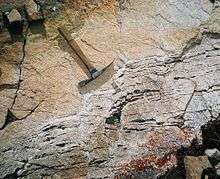
Chromite is found as orthocumulate lenses of chromitite in peridotite from the Earth's mantle. It also occurs in layered ultramafic intrusive rocks.[14] In addition, it is found in metamorphic rocks such as some serpentinites. Ore deposits of chromite form as early magmatic differentiates. It is commonly associated with olivine, magnetite, serpentine, and corundum. The vast Bushveld Igneous Complex of South Africa is a large layered mafic to ultramafic igneous body with some layers consisting of 90% chromite making the rare rock type, chromitite.[15] The Stillwater Igneous Complex in Montana also contains significant chromite.[2]
Chromite is found in large quantities that is available for commercial mining. The chromite minerals are found in 2 main deposits, which are stratiform deposits and podiform deposits. Stratiform deposits in layered intrusions are the main source of chromite resources and are seen in countries such as South Africa, Canada, Finland, and Madagascar. Chromite resources from podiform deposits are mainly found in Kazakhstan, Turkey, and Albania. Zimbabwe is the only country that can obtain chromite resources from both stratiform and podiform deposits.[16]
Stratiform deposits
Stratiform deposits are formed as large sheet-like bodies, usually formed in layered mafic to ultramafic igneous complexes. This type of deposit is used to obtain 98% of the worldwide chromite reserves.[17]
Stratiform deposits are typically seen to be of Precambrian in age and are found in cratons. The mafic to ultramafic igneous provinces that these deposits are formed in were likely intruded into continental crust, which may have contained granites or gneisses. The shapes of these intrusions are described as tabular or funnel-shaped. The tabular intrusions were placed in the form of sills with the layering of these intrusions being parallel. Examples of these tabular intrusions can be seen in the Stillwater Igneous Complex and Bird River. The funnel-shaped intrusions are seen to be dipping towards the center of the intrusion. This gives the layers in this intrusion a syncline formation. Examples of this type of intrusion can be seen in the Bushveld Igneous Complex and the Great Dyke.[17]
Chromite can be seen in stratiform deposits as multiple layers which consist of chromitite. Thicknesses for these layers range between 1 cm to 1 m. Lateral depths can reach lengths of 70 km. Chromitite is the main rock in these layers, with 50–95% of it being made of chromite and the rest being composed of olivine, orthopyroxene, plagioclase, clinopyroxene, and the various alteration products of these minerals. An indication of water in the magma is determined by the presence of brown mica.[17]
Podiform deposits
Podiform deposits are seen to occur within the ophiolite sequences. The stratigraphy of the ophiolite sequence is deep-ocean sediments, pillow lavas, sheeted dykes, gabbros and ultramafic tectonites.[17]
These deposits are found in ultramafic rocks, most notably in tectonites. It can be seen that the abundance of podiform deposits increase towards the top of the tectonites.[17]
Podiform deposits are irregular in shape. "Pod" is a term given by geologists to express the uncertain morphology of this deposit. This deposit shows foliation that is parallel to the foliation of the host rock. Podiform deposits are described as discordant, subconcordant and concordant. Chromite in podiform deposits form as anhedral grains. The ores seen in this type of deposit have nodular texture and are loosely-packed nodules with a size range of 5–20 mm. Other minerals that are seen in podiform deposits are olivine, orthopyroxene, clinopyroxene, pargasite, Na-mica, albite, and jadeite.[17]
Health effects
Chromite ore can be mined to produce chromite concentrate. It can also be crushed and processed. Chromite concentrate, when combined with a reductant such as coal or coke and a high temperature furnace can produce ferrochrome.[18] Ferrochrome is a type of ferroalloy that is an alloy in between chromium and iron. This ferroalloy, as well as chromite concentrate can introduce various health effects.
Chromite ore is found in underground conditions. Therefore, when exposed to aboveground conditions, various effects will occur. Some of these effects include weathering and oxidation. The element chromium is most abundant in chromite in the form of trivalent (Cr-III). When chromite ore is exposed to aboveground conditions, Cr-III can be converted to Cr-VI, which is the hexavalent state of chromium. Cr-VI is produced from Cr-III by means of dry milling or grinding of the ore. This mostly has to do with the moistness of the milling process as well as the atmosphere in which the milling is taking place. A wet environment and a non-oxygenated atmosphere are ideal conditions to produce less Cr-VI, while the opposite is known to create more Cr-VI.[18]
Production of ferrochrome is observed to emit pollutants into the air such as nitrogen oxides, carbon oxides and sulfur oxides, as well as dust particulates with a high concentration of heavy metals such as chromium, zinc, lead, nickel and cadmium. During high temperature smelting of chromite ore to produce ferrochrome, Cr-III is converted to Cr-VI. As with chromite ore, ferrochrome is milled and therefore produces Cr-VI. Cr-VI is therefore introduced into the dust when the ferrochrome is produced. This introduces health risks such as inhalation potential and leaching of toxins into the environment.[18]
Applications
Chromite can be used as a refractory material, because it has a high heat stability.[19] The chromium extracted from chromite is used in chrome plating and alloying for production of corrosion resistant superalloys, nichrome, and stainless steel. Chromium is used as a pigment for glass, glazes, and paint, and as an oxidizing agent for tanning leather.[20] It is also sometimes used as a gemstone.[21]
Porcelain tile pigmentation
Porcelain tiles are often produced with many different colours and pigmentations. The usual contributor to colour in fast-fired porcelain tiles are black (Fe,Cr)
2O
3 pigment, which is fairly expensive and is synthetic. Natural chromite allows for an inexpensive and inorganic pigmentation alternative to the expensive (Fe,Cr)
2O
3 and allows for the microstructure and mechanical properties of the tiles to not be substantially altered or modified when introduced.[22]
Stainless steel manufacturing
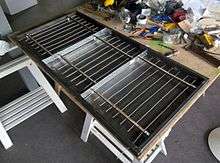
Chromium, which is mostly composed of chromite, is a main constituent in the manufacturing of stainless steel. Stainless steel contains 18% chromium. Chromium allows for the stainless steel to be hardened and toughened. It also allows for corrosion resistance at high temperatures.[23] 90% of mined chromite ore is used for stainless steel production. Chromite ore production has been on a steady incline, which causes a rise in demand for the stainless steel markets.[16]
Nichrome alloys
Chromite, when alloyed with iron and nickel creates an alloy called nichrome. Nichrome is described as being 80% nickel and 20% chromium. Due to the alloys that make nichrome, nichrome is seen to be heat resistant up to temperatures of 1250 °C (2282 °F). Due to the high heat resistance of nichrome, it is mainly used for heating units. Nichrome alloys also have very good mechanical properties which allow for good oxidation and corrosion properties.[24]
Gallery of chromite mineral specimens
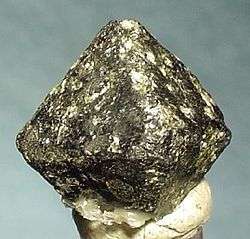 Octahedral chromite crystal from the Freetown Layered Complex in Sierra Leone, Africa (size: 1.3 x 1.2 x 1.2 cm)
Octahedral chromite crystal from the Freetown Layered Complex in Sierra Leone, Africa (size: 1.3 x 1.2 x 1.2 cm)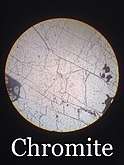 Chromite sample under a petrographic microscope in plain polarized light (PPL)
Chromite sample under a petrographic microscope in plain polarized light (PPL)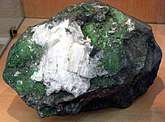 Chromite grains with white calcite grains
Chromite grains with white calcite grains
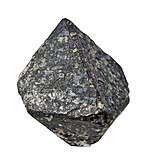 Large, equant chromite crystals from Hangha, Kenema District, Eastern Province, Sierra Leone
Large, equant chromite crystals from Hangha, Kenema District, Eastern Province, Sierra Leone
References
- Anthony, John W.; Bideaux, Richard A.; Bladh, Kenneth W.; Nichols, Monte C. Chromite (PDF). Handbook of Mineralogy. Mineralogical Society of America. p. 122. Retrieved 13 April 2019.
- Klein, Corneis; Hurlbut, Cornelius S. (1985). Manual of Mineralogy (20th ed.). Wiley. pp. 312–313. ISBN 0471805807.
- "Chromite Mineral Data". Webmineral data. Retrieved 13 April 2019.
- Hudson Institute of Mineralogy. "Chromite: Mineral information, data and localities". Mindat.org. Retrieved 13 April 2019.
- Hudson Institute of Mineralogy. "Chromite-Magnesiochromite Series: Mineral information, data and localities". Mindat.org. Retrieved 13 April 2019.
- Hudson Institute of Mineralogy. "Chromite-Hercynite Series: Mineral information, data and localities". Mindat.org. Retrieved 13 April 2019.
- "Potential Toxic Effects of Chromium, Chromite Mining and Ferrochrome Production: A Literature Review" (PDF). May 2012. Retrieved March 15, 2019.
- Hurlbut, Cornelius S.; Sharp, W. Edwin; Dana, Edward Salisbury (1998). Dana's minerals and how to study them (4th. ed.). New York: Wiley. ISBN 0471156779. OCLC 36969745.
- Latypov, Rais; Costin, Gelu; Chistyakova, Sofya; Hunt, Emma J.; Mukherjee, Ria; Naldrett, Tony (2018-01-31). "Platinum-bearing chromite layers are caused by pressure reduction during magma ascent". Nature Communications. 9 (1): 462. Bibcode:2018NatCo...9..462L. doi:10.1038/s41467-017-02773-w. ISSN 2041-1723. PMC 5792441. PMID 29386509.
- Fehr, Karl Thomas; Carion, Alain (2004). "Unusual large chromite crystals in the Saint Aubin iron meteorite". Meteoritics & Planetary Science. 39 (S8): A139–A141. Bibcode:2004M&PS...39..139F. doi:10.1111/j.1945-5100.2004.tb00349.x. ISSN 1086-9379. S2CID 55658406.
- Fortier, Y. (1941). "Geology of Chromite". McGill University.
- Eric, Rauf Hurman (2014), "Production of Ferroalloys", Treatise on Process Metallurgy, Elsevier, pp. 477–532, doi:10.1016/b978-0-08-096988-6.00005-5, ISBN 9780080969886
- "CHROMITE (Iron Chromium Oxide)". www.galleries.com. Retrieved 2019-03-17.
- Gu, F; Wills, B (1988). "Chromite- mineralogy and processing". Minerals Engineering. 1 (3): 235. doi:10.1016/0892-6875(88)90045-3.
- Guilbert, John M., and Park, Charles F., Jr. (1986) The Geology of Ore Deposits, Freeman, ISBN 0-7167-1456-6
- Prasad, M. N. V.; Shih, Kaimin, eds. (2016-04-19). Environmental materials and waste : resource recovery and pollution prevention. London. ISBN 9780128039069. OCLC 947118220.
- Duke, J. M. Ore deposit models 7 : Magmatic Segregation Deposits of Chromite. OCLC 191989186.
- Potential Toxic Effects of Chromium, Chromite Mining and Ferrochrome Production : A Literature Review. MiningWatch Canada. 2012. OCLC 1059182319.
- Routschka, Gerald (2008). Pocket Manual Refractory Materials: Structure - Properties - Verification. Vulkan-Verlag. ISBN 978-3-8027-3158-7.
- "Chromite Mineral, Iron Chromium Oxide, Chromite Uses, Chromium Oxide Properties". Archived from the original on 8 January 2017. Retrieved 21 March 2014.
- Tables of Gemstone Identification By Roger Dedeyne, Ivo Quintens, p.189
- Bondioli, Federica; Ferrari, Anna Maria; Leonelli, Cristina; Manfredini, Tiziano (1997), "Chromite as a Pigment for Fast-Fired Porcelain Tiles", 98th Annual Meeting and the Ceramic Manufacturing Council's Workshop and Exposition: Materials & Equipment/Whitewares: Ceramic Engineering and Science Proceedings, Volume 18, Issue 2, Ceramic Engineering and Science Proceedings, 18, John Wiley & Sons, pp. 44–58, doi:10.1002/9780470294420.ch6, hdl:11380/448364, ISBN 9780470294420
- Kropschot, S.J.; Doebrich, Jeff (2010). "Chromium-Makes Stainless Steel Stainless". Fact Sheet. doi:10.3133/fs20103089. ISSN 2327-6932.
- "Improvement of Nichrome Wire Heating". www.heating-element-alloy.com. Retrieved 2019-03-18.